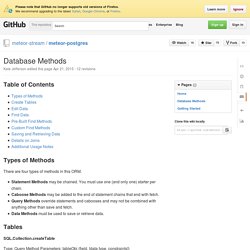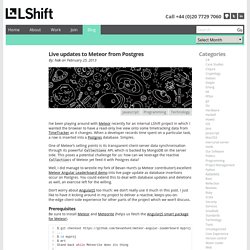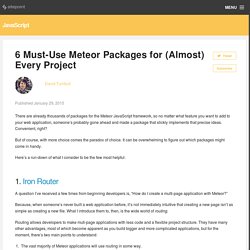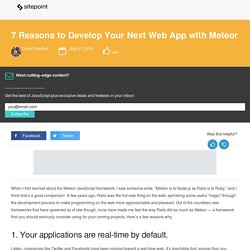

Database Methods · meteor-stream/meteor-postgres Wiki. Table of Contents Types of Methods There are four types of methods in this ORM.

Statement Methods may be chained. You must use one (and only one) starter per chain.Caboose Methods may be added to the end of statement chains that end with fetch. Query Methods override statements and cabooses and may not be combined with anything other than save and fetch.Data Methods must be used to save or retrieve data. Tables SQL.Collection.createTable Type: Query Method Parameters: tableObj (field, [data type, constraints]) CREATE TABLE field data type constraint createtable is required for all SQL collections. Getting Started · meteor-stream/meteor-postgres Wiki. Welcome to Meteor-Postgres.

This document provides a brief introduction to Meteor-Postgres. Create a SQL Collection In a JS file that's loaded on the client and the server, instantiate your SQL collections. var connectionString = ' tasks = new SQL.Collection('tasks', connectionString); usernames = new SQL.Collection('usernames', connectionString); Setting up server The following code should run inside: if (Meteor.isServer){ } Creating tables on the Server Tables created on the client are not persistent and will need to be recreated each time the code runs. See Detailed Database Methods for more info. Setting up data available to the client The select statement generated by the .publish method will be the data used to populate the client.
Username.publish('username', function(){ return username.select('id', 'name') .limit(100) }); LShift - Live updates to Meteor from Postgres. I’ve been playing around with Meteor recently for an internal LShift project in which I wanted the browser to have a read-only live view onto some timetracking data from TimeTracker as it changes.

When a developer records time spent on a particular task, a row is inserted into a Postgres database. Simples. One of Meteor’s selling points is its transparent client-server data synchronisation through its powerful Collections API, which is backed by MongoDB on the server side. This poses a potential challenge for us: how can we leverage the reactive Collections of Meteor yet feed it with Postgres data?
Well, I did manage to wrestle my fork of Bevan Hunt’s (a Meteor contributor!) Don’t worry about AngularJS too much: we don’t really use it much in this post. Prerequisites. Meteor Kitchen. Meteor #22: The Best Meteor Packages You Must Know To Code Faster Than Ever. Regarding productivity, Meteor is undoubtedly one of the best frameworks you can find.

But do you know that you can even be more efficient by knowing some of the most useful packages built by the community? There are currently 3500+ packages available on Atmosphere and they cover a wide range of use cases. We tried in this article to reference the most complete packages in order to save you time. New packages are created every week and a great way to stay up-to-date is to check the package category on Crater or the most recent packages pushed to Atmosphere. If we missed an important one that caught your attention, please add a comment. 6 Must-Use Meteor Packages for (Almost) Every Project. There are already thousands of packages for the Meteor JavaScript framework, so no matter what feature you want to add to your web application, someone’s probably gone ahead and made a package that slickly implements that precise ideas.

Convenient, right? But of course, with more choice comes the paradox of choice. It can be overwhelming to figure out which packages might come in handy. Here’s a run-down of what I consider to be the few most helpful: Reactjs/react-meteor. 7 Reasons to Develop Your Next Web App with Meteor. When I first learned about the Meteor JavaScript framework, I saw someone write, “Meteor is to Node.js as Rails is to Ruby,” and I think that’s a good comparison.

A few years ago, Rails was the hot new thing on the web, sprinkling some useful “magic” through the development process to make programming on the web more approachable and pleasant. Out of the countless new frameworks that have spawned as of late though, none have made me feel the way Rails did as much as Meteor — a framework that you should seriously consider using for your coming projects. A Beginners Guide to Mobile Development with Meteor. Out of the box, the Meteor JavaScript framework includes Cordova, “a set of device APIs that allow a mobile app developer to access native device functions such as the camera or accelerometer from JavaScript”.

If you’re a web developer who wants to release their work on iOS and Android (while harnessing the features of those platforms), you don’t have to learn a new language or entirely new concepts. You just need a basic grasp of Meteor, and then a basic grasp of details specific to mobile development. Step #1: Prepare for mobile development with Meteor. Obviously, you’ll need to install Meteor on your computer if you’re looking to develop with it. You’ll need a basic grasp of Meteor, so either check out the “Learning Resources” section of the official website, or the book I wrote for beginners.